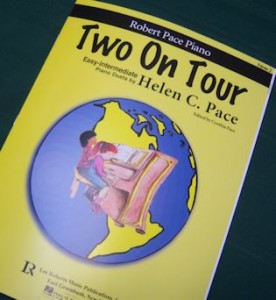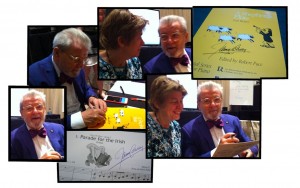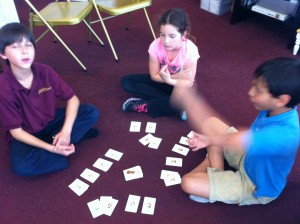Our “Funny” Clock

“I can’t read that clock,” exclaims a seven year old students in dismay about our clock on the studio wall. “Why does it have letters instead of numbers?” They want to know. After they figure it out, it’s like being part of a secret club or breaking a mysterious code.
We love our “circle of fifths” clock. The circle of fifths helps us understand the basic structure of musical composition that has been in use in so called western music from the early 1700s through the present time.
In our circle of 5ths clock, C is at the top. Counting five notes in order up the scale CDEFG brings you to G likewise GABCD brings you to D etc. Each key is 5 notes up from the previous one. Since we are using scale notes, the fifth note of B scale takes us to F# (A/K/A G flat) from F# we work our way back by 5ths up to C.
The circle represents many things to us, most importantly how scales are interrelated, and how chords follow a downward path of 5ths to resolution. In a simple example, a song ending in the key of C would always have a G chord (or G7) immediately preceeding it. Further it likely would go from D to G to C, or even further down the circle, from E minor to A minor to D minor to G to C. If the song were in the key of G, it would always need to end in D7 then come home to G. 300 years of conditioning have caused our ears to expect this resolution. As an example, think through Happy Birthday to You, but stop directly before the end of the song, on TO.. and notice the gravitational pulled toward YOU. It almost seems impossible to stop at “TO”.
Our students begin learning the first five notes of all 12 scales (which lay under 5 fingers comfortably), and they learn that every scale follows the same pattern of construction. From these scales we can change one note, and easily learn all 12 minor scales, as well as all 24 major and minor chords by playing only fingers 1 – 3 and 5; immediate transfer of learning from one concept to another. This is one of the unique aspects of the teaching approach we use. Students learn that we can transpose a song into any other key thus experiencing early the thrill of having the song “sound right” no matter what key they choose.
Being able to transpose a song into other keys is one of the primary skills of a competent keyboard musician because it allows him or her to accommodate the music according to the needs of other instruments and particularly singers who often need to change the key to accommodate their vocal range. This is a fundamental aspect of comprehensive musicianship and why what we teach is more than simply piano lessons. It is our goal that LSMS students be able to play music, not just play songs.
We learn to read and write key signatures. We learn a simple chord formula for applying the two important chords to a song (“when your melody uses notes 1 – 3 or 5, use the One chord, when it falls on scale degrees 2 or 4, use the Five chord”. Later, we fill in all 8 notes of each major and minor scale, learning additional chords and how to apply them to the other scale notes of the melody, and become familiar with other positions of the basic chords (inversions); more complex types of chords and applications of the chord formula.
Building this solid understanding of musical construction one step at a time makes music more accessible to students in many ways. First, they know how to interpret more intuitively (for example a “home: chord might be accented , or have a slight hesitation or ritard, a “five” chord might imply acceleration or crescendo) ; how to memorize more confidently and sight read more easily by knowing what chords will be involved in the piece; how to read chord charts or fake books; how to appreciate the structure of the piece and be in on the thrill of anticipating the expected sound and satisfaction of arrival; how to transfer the concepts that are so easy to see in the piano’s linear layout to other instruments which are not so visually obvious; how to compose their own pieces or apply accompaniments to music.
Next time you stop in, if you still can’t read the clock, ask your child. But don’t worry–there are little tiny numbers on the side if you need help.
 We observed how personable he was with each visitor taking time time to have a short chat while simultaneously playing chess via his cell phone with a friend online between visitors.
We observed how personable he was with each visitor taking time time to have a short chat while simultaneously playing chess via his cell phone with a friend online between visitors.



![CompCrds_FB[small]](http://lakeshoremusicstudio.com/blog/wp-content/uploads/2013/07/CompCrds_FBsmall.jpg)
